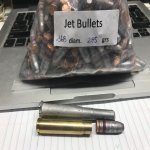There will not be any case body stretching occurring, if the shoulder is within a thou or so of the chamber shoulder, and the case head hard on the bolt face - the idea of sizing new, never fired brass to make that "false shoulder" is so the case body fire forms to the chamber with no stretching going on. Once you have the case matched to the chamber, do not want to re-size it any more than needed to re-chamber - so do not want to push that case shoulder back again, regardless of how the die instructions say to do re-sizing. Can not "undo it" however - I have seen on multiple 303 British - factory fired cartridges - definite ring inside felt with wire. Nothing that you can do to "undo" that - was done on that first firing of a case that was not tight - case head to shoulder - in that chamber. (For rimmed case like 303 British, also requires some "slop" in the headspace dimension for that case rim)
Just inserting a factory cartridge in an over long chamber and fire it, may not be fire forming it without that "incipient case head separation" - under firing pressure, the case is going to expand in every direction to fill the chamber - I think starting by grabbing chamber walls first. If there was "slop", the firing pin moved the case forward in the chamber - hence the case head is going to get blown back tight to the bolt face - stretching that case wall area just in front of the case head, which creates that "ring" - if the distances involved exceed the "spring back" within the brass alloy. I think.








































































